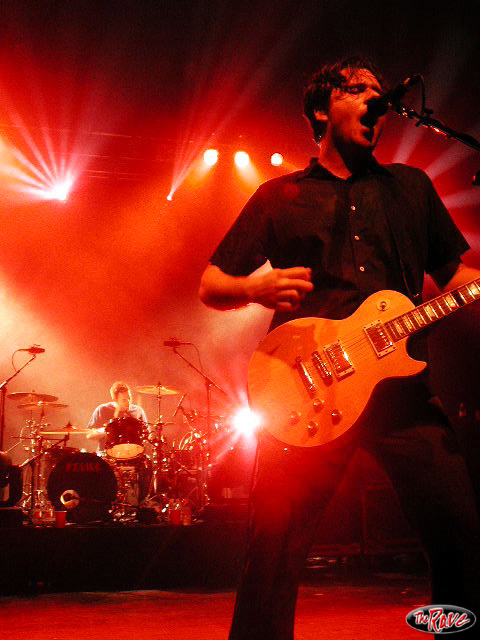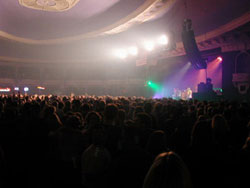





A Lifetime of Music:
Eagles Ballroom
defined by the times
by Danielle Chase
|
Once a site of ballroom dancing,
the Eagles Ballroom is now host to concerts from a variety of music
genres. |
An alluring young
lady sits at a lonely table waiting to be noticed in her elegant gown.
Although she is surrounded by clinking martini glasses, chattering couples
and a string orchestra, her gaze is distant and somewhat bored.
Suddenly, the crowd parts and he appears. A dashing, young tuxedo-clad
gentleman strolls over to her table, leans down and offers the sweet words
of relief, “May I have this dance?”
She nods yes and the couple begins to twirl about the dance floor of a
grandiose ballroom. Like a scene from an old black-and-white movie, this
was a night at the Eagles Million Dollar Ballroom in 1926.
Fast-forward to the same location nearly seven decades later. Wailing
drums, screaming fans and screeching electric guitars rattle the rafters.
A quirky, yet alluring young lady in a black t-shirt and worn-out jeans
pushes her way through the tightly packed crowd. Her sneakers stumble
upon empty plastic beer cups.
From of the corner of her eye she sees a dark, sweaty human form surf
across the top of the crowd and crash toward her. She ducks just in time
to avoid colliding with an unyielding combat boot.
As the crowd drops him to the floor right beside her, she offers her hand
and helps him avoid the stomping feet. He smiles, she smiles back and
they begin to bounce up and down to the beating bass. Like the scene of
a romance movie from hell, this is a night at the Eagles Ballroom in 1991.
The early years
For more than 76 years the Eagles Ballroom has stood heroically on Wisconsin
Avenue in the heart of downtown Milwaukee. Originally an elite men’s
only club built by the national Fraternal Order of Eagles, the club was equipped
with a gymnasium, racquetball courts, bowling alleys, indoor swimming pool,
massage parlor, numerous lounges and, of course, one of the finest ballrooms
of the time.
The building remained exclusive until 1934, when George Devine leased the
ballroom from the Fraternal Order of Eagles and opened it to the public. During
the 1930s and 1940s, the Eagles Ballroom, often called George Devine’s
Ballroom, was the premiere place for an evening of dancing.
Weekly events featured free ballroom dancing lessons every Monday night and
general admission dancing every Saturday and Sunday. Popular bands such as
Brandy and His Singing Orchestra frequented the stage and crowds came in the
thousands to dance along.
In remembering the decadence of the ballroom, Elizabeth Vanderhoof, 90, reminisces,
“The Eagles Ballroom was well-known for being fancy and breathtaking.
It was a time of big bands and popular for its ability to attract huge crowds
of people.” In essence, the Eagles Ballroom embraced the sounds and
styles of early jazz and swing and became a showcase for those genres.
With the onset of World War II, Devine reached out to teenage jive fans by
holding underage dances on Wednesday nights. Instead of liquor, teenagers
were offered ice cream, chocolate sodas and soft drinks. Over 600 hundred
teens attended on the first night and the numbers grew from there.
This success continued in the 1950’s, as big band remained popular.
“The ballroom was smoky and dark when you walked in,” recalls
Cathy Hewitt, who used to go in the 1950s. “There were tables in the
back and dancing room in front of the tables leading up to the stage. But
I remember standing on the side of the stage and just watching the steam come
out of the trumpet. It was the music—I was there for the music.”
Tragedy struck the ballroom in 1955, when a smoldering cigarette ignited a
five-alarm fire that burnt down the bandstand at the south end of the oval
and cost $500,000 in damage. At the time Devine said, “They’ll
never dance on that floor again.” The ballroom’s doors closed
for five months and then re-opened after extensive reconstruction.
The turbulent
60s lead to silence in the 70s
Following the peak of big band and swing dancing in the 1950s, the Eagles
Ballroom endured another change in music tastes and began to accommodate fans
of rock ’n’ roll in the 1960s. Although the Eagles Ballroom tried
to keep with the times, Hewitt said, “As soon as rock ’n’
roll took off, the ballroom wasn’t the same and its popularity began
to decline.” In addition, the Eagles Ballroom still was notoriously
exclusive to whites and by 1964 the black community sought to change its discriminatory
policies.
The battle between the black community and the Eagles Ballroom lasted over
five years. In the beginning, black protestors marched alone, but it was not
long before their daily pickets had the support of black and white students,
people young and old, members of the NAACP, and even clergy and nuns. The
most surprising protestors were members of the Fraternal Order of Eagles,
the very organization whose policies the demonstrators were protesting against.
In support of the racist policy, white protestors and Ku Klux Klan members
appeared at the demonstrations and it was not long before protests spun into
riots. By 1966, the National Guard had been stationed on 24th Street to squelch
any riots. The protests lasted until 1969. Finally, in 1970, the national
board of the Fraternal Order of Eagles gave local chapters the right to draft
their own acceptance policies.
However, it wasn’t until 1971 that the Eagles Ballroom removed Caucasian
from their admittance criteria. Even this action lacked a measurable amount
of change towards acceptance. Nine years later, in May 1980, the facilities
finally were opened to everyone and shortly following the Fraternal Order
of Eagles relocated.
In the meantime, the 1970s marked a long hibernation from live music, as the
Eagles Ballroom could not compete with large-arena rock tours, a tainted reputation
and financial problems. Head of Security Ricky Stardy said, “The neighborhood
started falling apart in the 1960s and got badly run-down in the 1970s, including
the Eagles Ballroom.” In lieu of concerts, the Eagles Ballroom played
host to an eclectic mix of boxing matches and wedding receptions.
The rebirth
A ringing alarm clock awakened the slumbering ballroom in the late 1980s and
early 1990s and the screech of electric guitars sent chills of excitement
bouncing to the rafters. “It wasn’t until the early 1990s when
bands really started playing there again,” recalls Savon Schwartz, Eagles
Ballroom publicist. Given a second chance to redeem itself, the Eagles Ballroom
celebrated a unique diversity of music in order to reach a wide variety of
people.
 |
| Jimmy Eats World rocks out at the Eagles Ballroom.
Photo courtesy of Rob Miller |
During its rebirth, grunge
music stomped down the doors and up the stairs to the Eagles Ballroom. Crowds
now came to take their turn in the mosh pit or push their way to the front
row in hopes of catching a glimpse of the latest grunge rock god. During the
early 1990s, acts such as Pearl Jam played in the Eagles Ballroom and left
the ballroom at the end of the night with sweat dripping from the ceiling.
Smashing Pumpkins, another band to grace the stage, performed similar concerts
as Nikki Zenoni, 19, remembers, “The show was sold out and the crowd
was sweaty and hot, the way it should be. Moshing was expected and enjoyed.”
This tradition carries on in this specific music genre even today.
After the initial onset of grunge, the Eagles Ballroom became the home of
upcoming alternative rock bands. Greg Peterson, 29, says, “I remember
seeing Dave Matthews Band open for Big Head Todd and the Monsters. They were
amazing even then.” The Dave Matthews Band now plays 40,000-person venues,
and The Eagles Ballroom is simply a small side note in their rise to fame.
Today, the Eagles Ballroom welcomes all music genres including hip-hop, alternative
rock, jam bands, ska, emo, punk, metal, country and classic rock. Recent acts
include The Strokes, Jimmy Eat World, The Black Crowes, The Roots and Weezer.
The crowd can be rowdy or subdued, depending on the band, as well as the age
and music tastes of those in attendance.
The building also now
has three smaller stages, the Rave, the Rave Bar and the Rave II. These venues
hold together the subculture of the avant-garde music scene, functioning as
stepping-stones in a band’s progression to popularity.
Like a movie set, the scenery at the Eagles Ballroom never stays the same.
Renovations are a constant process due to the age of the building. The Eagles
Ballroom proudly wears a new shade of paint, walls have been moved and bowling
lanes have become bars.
Like the cast of a movie, the bands, the fans and the workers are constantly
entering and exiting through the massive doors of the Eagles Ballroom.
And like the script of a movie, the history of the Eagles Ballroom tells a
flawed account of important people and meaningful places. For the moments
that have no words, the soundtrack fills the silence.
Perhaps what can be best said of the Eagles Ballroom remains in its concrete
roots that started out small and narrow, but have grown over the decades to
stretch over city blocks, binding people together with music.
